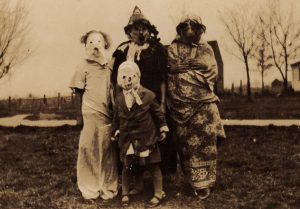
The story of evil that is shadowing upon god’s green earth will be told for generations to come.
It begins in a cold dark place in a time unknown to mankind, a group of men and women with shaved heads, wearing tight black clothing and plain silver coloured masks to cover up their multiple stab-like wounds that are symbolic of their rough experiences that have made them preach evil upon each other and the rest of the world. The group thrived on one thing and one thing only…. blood. This blood thirsty group was seeking to take over the world.
The leader of the group, Mary, has been informed that one of the members of this group has plotted to leave the group and run away. Furious, she demands to know who this individual is and reminds the group of the consequences for anyone planning to run away. In her hand, Mary held a device, one which can detect the presence of a non-believer and a guilty conscience which is contradictory to the dominant evil belief system that defines this group. Determined to find who this non-believer is, she turns on her device slowly walking around the circle, with each step around the circle getting closer to the culprit, her evil laugh getting louder with each step as she makes her way around the circle.
Then all of a sudden, there is a loud “beep beep beep” indicating a sense of a non-believing guilty conscience in this dark room, that pointed right at Jimmy, the newest addition to the group at the age of 18, who was now forced to tell the story about the culprit, who is also his lover.
“It was Donna; she told me how she needs to escape into the other world to escape this evil, to see what its like to replace evil with love”. Said Jimmy.
“Donna my dear…could you please stand up and walk towards me”. Said Mary, the leader of this blood thirsty demonic cult.
Face to face, Mary holding a sharp long knife to the bottom of Donna’s throat in front of the entire group reminding her of the blood-thirsty consequences of those who attempt to leave the group.
“Okay I’m sorry, I take what I said about leaving this group back and promise to stay loyal to this group going forward.” Donna pleads with Mary.
“But, of course, it was too late. For once a story is told, it cannot be called back. Once told, it is loose in the world.” (King 10).
— Commentary–
I would like to believe that I was good at telling stories prior to my enrolment in this course, but considering Thomas King’s notion of being unable to take back stories once they are told, makes me question the true impact that my stories have had on the lives of my friends and family. What I have discovered about story telling is how to strategically word a story in a way that will pull my audience in and make sure that I don’t lose their attention. For example, when I was telling this story to my friends, I had to place emphasis on words that I believe would cater to their attention the most…like placing emphasis on the fact that Jimmy had to confess about Donna, who was also his lover. I also learnt the importance of incorporating a mystery embedded in the ‘element of the unknown’, which kept my audience asking questions and wanting to learn more after I had told the story. For example, my friend was curious what exactly I meant by ‘consequences’ and also what ended up happening to Donna in the end.
The impact that cliffhangers have in the art of story telling was something I found to be interesting, the cliff hangers in my story lead my audience asking questions and wanting more.
Works Cited
Grant, S. Vintage Halloween Masks. 2014. List Verse, United States of America. List Verse. Web. 30 May 2016.
Izo, Ivan. “How to Hook Your Readers with Cliffhangers and Story Tension.”Writer On Fire. 29 Dec. 2013. Web. 30 May 2016.
King, Thomas. The Truth About Stories: A Native Narrative. Toronto: House of Anansi, 2003. Print.
Zak, Paul J. “Why Your Brain Loves Good Storytelling.” Harvard Business Review. Harvard Business School Publishing, 28 Oct. 2014. Web. 30 May 2016.


